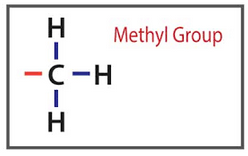Part 3 of 4
The following is based on “The Study & Protocol As Approved by The UCSF Medical School CHR.” That’s where you will find the citations, footnotes and scientific details. Also, please note that “Chemicals of Emerging Concern”?? (CEC) is synonymous with a subset of “Environmental Chemicals.” (EC)
Stealth Syndrome Study, Part 1: Where Did The Idea Come From?
Stealth Syndrome Study, Part 2: How Will The Process Work?
Stealth Syndrome Study, Part 4: How Do Science & Society Benefit?
One of the study’s toughest issues is?? the considerable effort needed to the control for potential confounding factors resulting from the epigenetic activity of methyl-contributing micronutrients (such as folate and genistein among others).
Epigenetic means that the activity of a gene is changed without an underlying change (mutation) in a gene. A methyl group is an molecule composed of three hydrogen atoms connected to a carbon atom.

Methyl groups are common in cells and like to form compounds. They can attach themselves to specific locations in the DNA and act in an epigenetic manner to change how the gene expresses itself.
Published work (references at the bottom) indicate that methyl-contributing micronutrients have demonstrated the ability to??significantly alter the known epigenetic effects of BPA. While those studies have been conducted with murine models, the possibility of parallel human effects unknown and could be of substantial concern.
As a result, the possible confounding factors of such micronutrients demand that the study determine reference levels of BPA and that of methyl-contributing micronutrients in the test subject diets on a meal-by-meal basis.
Instead of trying to establish pre-preparation levels of potentially confounding compounds in the food recipes, we propose establishing post-preparation concentrations in an exemplar of each meal which can establish reference points to examine what may be confounding results.
This would require the maceration of one exemplar of each standardized meal and the measurement of levels of BPA and methyl-contributing micronutrients in the supernatant. This would also continue for food and beverages consumed in weeks 7-9 and thus provide a quality control for resulting measurements.
Establishing the concentrations of methyl-contributing micronutrients, and pesticide residues in each meal offers a method to that can be used to control for those confounding factors.
In addition, tracking BPA in each meal may also point to previously unknown sources, especially if unexpected concentrations are found in the meals of weeks five through nine.